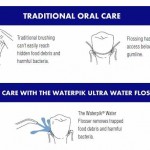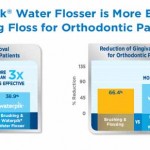 Waterpik is an oral irrigating system that uses a stream of water to clean the teeth as well as below the gum lines (also known as gingival margin). As brushing and flossing will not reach that area, plaque and bacteria can accumulate and proliferate, leading to gum diseases.
Waterpik is an oral irrigating system that uses a stream of water to clean the teeth as well as below the gum lines (also known as gingival margin). As brushing and flossing will not reach that area, plaque and bacteria can accumulate and proliferate, leading to gum diseases.
What are the indications of using waterpik?
It is often indicated in patients wearing braces (orthodontic patients) and patients with periodontal problems. This is because orthodontic patients will have difficulty cleaning their teeth through the fixed orthodontic appliance, and flossing is time consuming and tedious. Orthodontic patients, especially children and adolescents might not be complaint and skip flossing. When this happens, the plaque can accumulate between the braces and the teeth, leading to dental decay. This way, orthodontic treatment will bring more harm to the patient instead of benefiting the patient.
 Meanwhile, in patients with periodontal problems, they have deep periodontal pockets (the small space below the gum line) that cannot be cleaned through normal brushing and flossing. By using waterpik, the jet of water can be forced into the pockets and clean them thoroughly without hurting the gums or the patient.
Meanwhile, in patients with periodontal problems, they have deep periodontal pockets (the small space below the gum line) that cannot be cleaned through normal brushing and flossing. By using waterpik, the jet of water can be forced into the pockets and clean them thoroughly without hurting the gums or the patient.
What are the types of waterpik?
There are two types of waterpik – the countertop model and the cordless one. The countertop model can be used in a household setting as it has a fairly big reservoir to be filled with water, and this allows it to be used repeatedly by many people without having to refill it constantly. To encourage kids to floss regularly, a newly released countertop model is brightly coloured with many decorations placed on the reservoir.
While the cordless one can be carried around easily, so it is more suitable for individuals who always travel around.
It comes with six types of tips, each to be used in differently. They are the orthodontic tip, pickpocket tip, toothbrush tip, plaque seeker tip, classic jet tip and the tongue cleaner tip.
What makes waterpik better than normal flossing?
Waterpik is able to shoot a stream of mouthwash or antibacterial solution instead of just plain water. This furthers increases the cleaning ability of waterpik as even more bacteria can be eliminated. Therefore, it is not surprising that one of the first studies published in the late 1960s demonstrated that the Waterpik® Water Flosser significantly reduced gingivitis and calculus. Today, more than 50 studies have been conducted at 26 universities and independent research facilities. Collectively they demonstrate that the Waterpik® Water Flosser is safe, effective and provides superior oral health results. It also answered the age-old question “Can the Waterpik® Water Flosser help with patients who don’t floss?” with a resounding yes!
The most astonishing cleaning ability of waterpik is that it is capable of removing almost all of the plaque found around the teeth. The Classic Jet Tip was shown to have removed 99.9% and the Orthodontic Tip removed 99.8% of the plaque biofilm from the treated teeth areas after a 3-second exposure as viewed by scanning electron microscopy (SEM). Furthermore, the Orthodontic Tip is also able to significantly removed the calcified biofilm from the surface of the four teeth as viewed by the naked eye and SEM.
When used in a patient who has bleeding gums, after 14 days used in conjunction with manual toothbrushing, the the Waterpik® Water Flosser with the Classic Jet Tip was twice as effective as traditional floss at reducing gum bleeding. At 30 days, the relative improvement in gingival bleeding for the Water Flosser groups was even more dramatic.
When used in diabetic patients, adding the Waterpik® Water Flosser was superior to normal oral hygiene in reducing the traditional measures of periodontal disease: plaque biofilm, gingivitis, and bleeding on probing. The Water Flosser also reduced the serum levels of proinflammatory cytokines IL-1ß and PGE2, as well as the level of reactive oxygen species, a bacteria and host-mediated pathway for tissue destruction implicated in the pathogenesis of over 100 conditions. Therefore, it was concluded that the Waterpik® Water Flosser provided significant periodontal health benefits, both clinically and biologically to people with diabetes.
In patients who has implants, those who used the Waterpik® Water Flosser and the Pik Pocket™ Tip had significantly greater reductions in plaque biofilm, gingivitis, and stain than those who only rinsed with chlorhexidine. In fact, the Waterpik® Water Flosser was 87% more effective at reducing gingival bleeding than rinsing, as by reducing the bacterial load, it also leads to reduction of inflammation of the gums.
In many ways waterpik has proved itself to be more superior, easier, as well as time saving compared to all the conventional oral flossing. However, it must always be remembered that a good brushing technique must be established and not to only rely on waterpik.